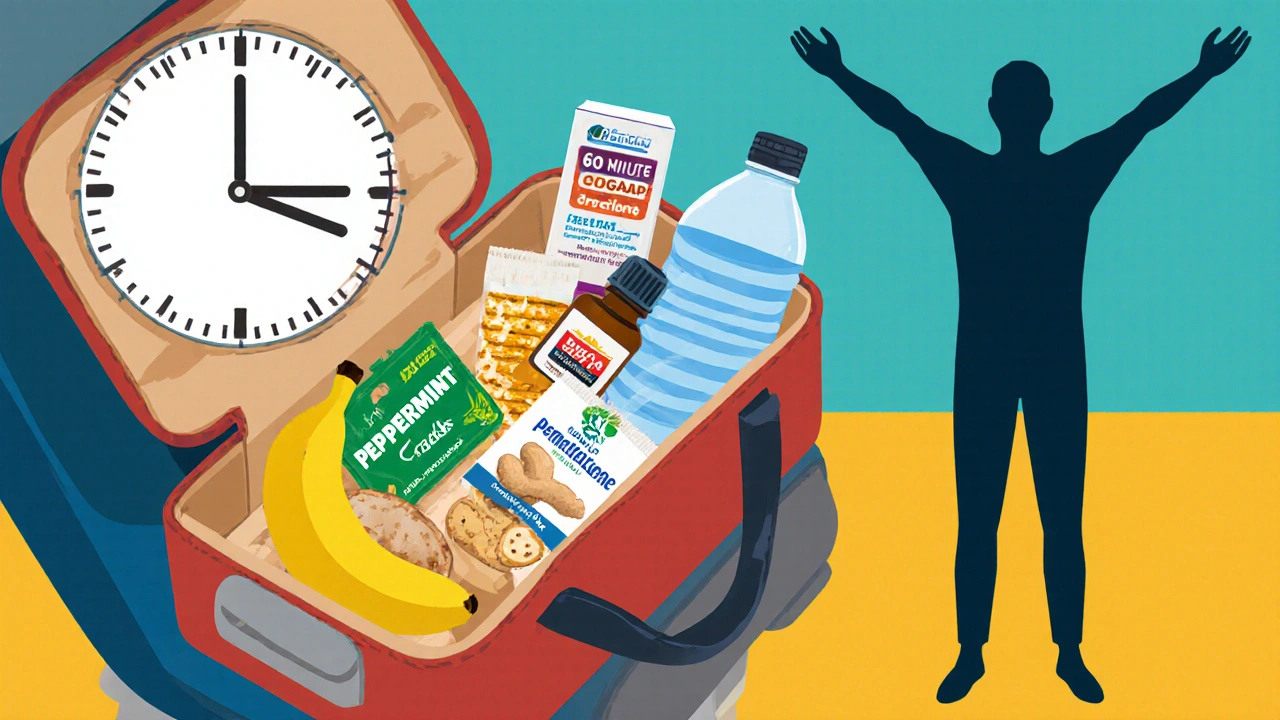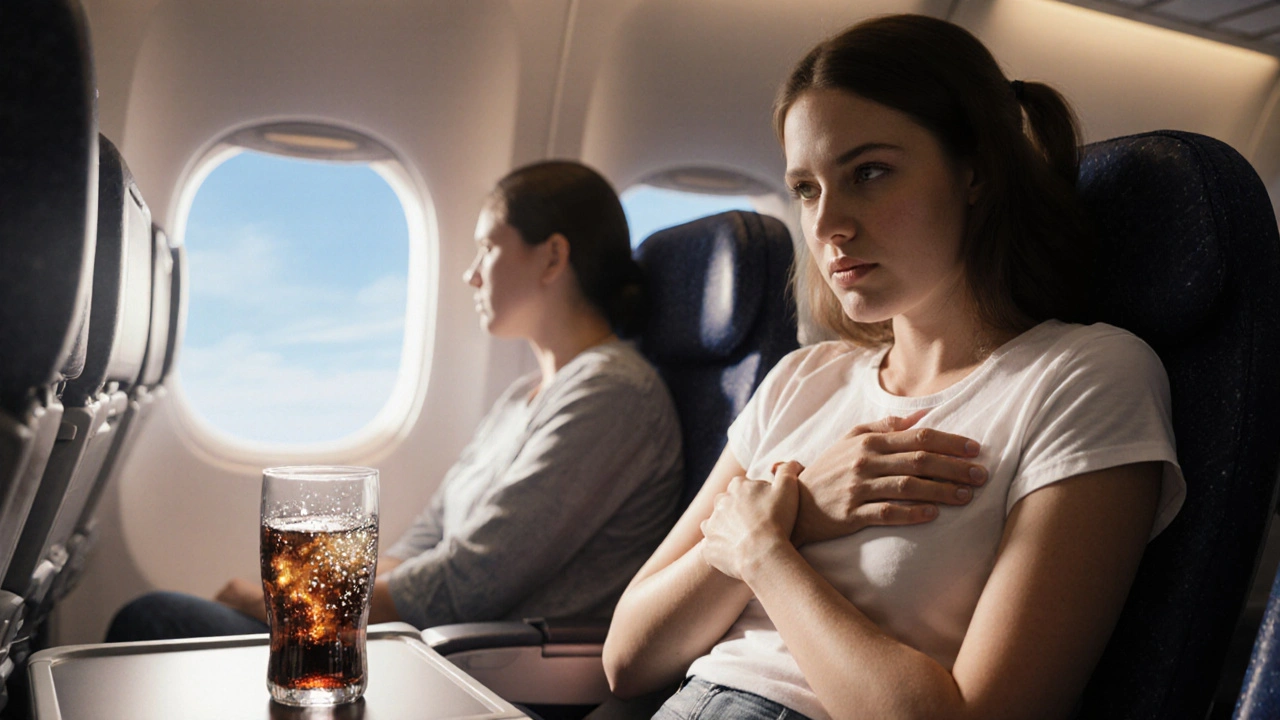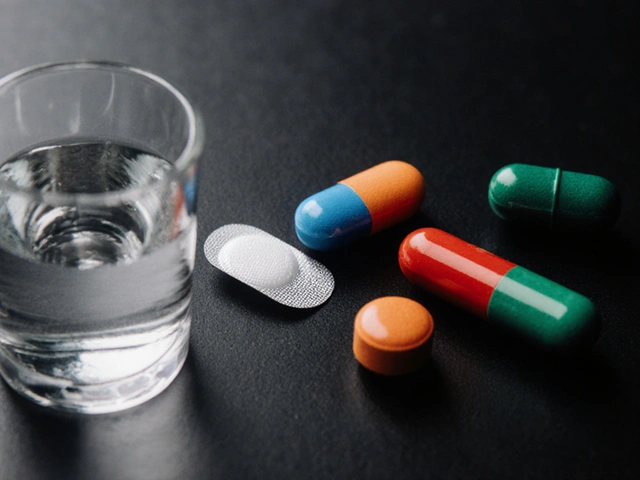Travel Gas Relief Calculator
Answer the following questions to assess your risk of experiencing meteorism during travel.
Your Travel Gas Risk Assessment
Ever feel like a balloon right before boarding a flight or hitting the highway? That uncomfortable swelling is called Meteorism - a medical term for excessive gas in the digestive tract. When you combine tight seats, unfamiliar foods, and the stress of moving, the odds of a noisy belly skyrocket. Below you’ll find a straight‑forward game plan to keep the gas at bay, whether you’re chasing sunrise in Iceland or hopping between New Zealand’s vineyards.
Quick Take
- Swap carbonated drinks for water or herbal tea at least 2hours before travel.
- Pack a small stash of easy‑digesting snacks like banana, ginger, or low‑FODMAP crackers.
- Move every 60‑90minutes - a quick walk or stretch prevents gas build‑up.
- Keep a pocket‑size anti‑gas remedy (simethicone or peppermint oil) for emergencies.
- Stay hydrated but sip slowly; gulping air fuels bloating.
What Is Meteorism?
Meteorism is a condition where excess gas accumulates in the stomach or intestines, causing distention, discomfort, and sometimes audible rumbling. The gas comes from two sources: swallowed air (aerophagia) and bacterial fermentation of undigested food. While occasional gas is normal, chronic meteorism can interfere with daily life and, on the road, ruin a great adventure.
Why Travel Triggers Gas
Travel throws several culprits together that amplify gas production:
- Prolonged Sitting: Tight airline seats or car seats compress the abdomen, slowing down the movement of food and trapping gas.
- Changes in Altitude: At higher altitudes, the lower air pressure expands trapped gas, making it feel bigger. Altitude can turn a modest bloating into a painful balloon.
- Stress and Anxiety: The gut is wired to the brain. Stress triggers the release of cortisol, which slows digestion and encourages gas‑producing bacteria. Stress is a silent driver of meteorism.
- Irregular Meal Timing: Skipping meals or eating large, heavy dishes late at night leaves food lingering in the stomach, giving bacteria more time to ferment.
Food & Drink to Watch
Not every tasty snack is travel‑friendly. Here are the usual suspects and smarter swaps:
- Carbonated Drinks - Soda, sparkling water, and beer introduce extra CO₂ that expands in the gut. Choose still water or herbal tea instead.
- Legumes - Beans, lentils, and chickpeas are high in oligosaccharides, which bacteria love to break down. If you must eat them, soak and rinse well, then spice with ginger or cumin.
- Dairy - Lactose can be a nightmare for those with low lactase activity. Opt for lactose‑free cheese or a splash of almond milk.
- High‑Fiber Foods - While fiber is essential, a sudden surge (think whole‑grain breads or raw veggies) can cause gas. Gradually increase intake and pair with low‑FODMAP choices.
- Sugar Alcohols - Found in sugar‑free gum and some snack bars, sorbitol and xylitol ferment quickly, leading to bloating.

Strategies to Prevent Gas While Traveling
These steps are easy to pack in a carry‑on and work in any timezone:
- Pre‑Travel Meal Planning: Eat a light, low‑FODMAP breakfast 2-3hours before departure. Good options: plain oatmeal with banana, or a rice cake topped with peanut butter.
- Hydration Rhythm: Sip water slowly throughout the journey. Aim for 150‑200ml every 30minutes rather than chugging a large bottle.
- Move Regularly: Stand, stretch, or walk the aisle every 60minutes. Simple calf raises and torso twists release trapped air.
- Chewing Discipline: Chew each bite at least 20 times. Thorough grinding reduces the size of undigested particles, limiting fermentation.
- Mindful Breathing: Practice diaphragmatic breathing (inhale through the nose for 4seconds, exhale through the mouth for 6seconds). This lowers stress‑induced gut motility changes.
Quick Remedies on the Road
If despite your best efforts a balloon starts to swell, reach for one of these pocket‑size solutions. The table below compares the most common over‑the‑counter (OTC) options.
| Remedy | How It Works | Typical Dose | Pros | Cons |
|---|---|---|---|---|
| Simethicone | Surface‑active agent that coalesces gas bubbles for easier passage. | 40mg after meals, up to 4times daily. | Fast‑acting, safe for most adults. | May not address underlying fermentation. |
| Activated Charcoal | Adsorbs gas‑producing compounds in the gut. | 250‑500mg before meals. | Broad‑spectrum, also reduces odor. | Can bind nutrients; avoid with vitamins. |
| Peppermint Oil Capsules | Relax smooth muscle, easing gas transit. | 0.2mL enteric‑coated capsule before meals. | Natural, also relieves IBS cramping. | May aggravate reflux in some users. |
| Probiotic Tablets | Introduce beneficial bacteria that outcompete gas‑producing strains. | 1‑2billion CFU daily. | Addresses root cause, supports overall gut health. | Benefit may take several days to appear. |
Gut‑Friendly Habits for Long Trips
Beyond quick fixes, building a gut‑friendly routine can make a massive difference on multi‑day journeys.
- Probiotic Boost: Carry a shelf‑stable probiotic blend (Lactobacillusrhamnosus, Bifidobacteriuminfantis). Taking it each morning helps keep the Gut Microbiome balanced.
- Gentle Enzyme Aid: A pinch of ginger powder or a small glass of pineapple juice supplies bromelain, an enzyme that breaks down proteins and reduces fermentation.
- Mindful Portion Control: Eat smaller meals more frequently. A 300‑gram plate limits the amount of food the bacteria can act on at once.
- Avoid Swallowing Air: Skip chewing gum and limit straw use. If you need fresh breath, rinse with a mouthwash instead.
When to Seek Medical Help
Most travel‑related meteorism is benign, but watch for red flags that merit a doctor’s attention:
- Severe, continuous abdominal pain that doesn’t improve after passing gas.
- Unintended weight loss or persistent diarrhea.
- Blood in stool or vomit.
- Fever above 38°C (100.4°F) accompanying bloating.
If any of these occur, seek local medical care promptly. In most cases, a brief tele‑consultation can guide you to the right clinic.
Frequently Asked Questions
Can I take anti‑gas meds on a plane?
Yes. Most OTC remedies like simethicone are allowed in both carry‑on and checked luggage. Keep the original packaging handy for security checks.
Is there a natural food that instantly relieves bloating?
Fresh ginger tea is one of the fastest-acting natural options. The gingerols relax intestinal muscles, allowing trapped gas to move out more easily.
How does altitude make gas feel worse?
Lower air pressure at altitude causes gases to expand (Boyle’s law). Even a small amount of trapped gas can swell noticeably, intensifying the feeling of bloating.
Should I avoid fiber entirely when traveling?
No. Fiber is crucial for regular bowel movements. Instead, choose soluble fiber sources (like oatmeal) and introduce them gradually before your trip.
What’s the best probiotic strain for preventing gas?
Lactobacillusrhamnosus GG has strong evidence for reducing gas production and supporting overall digestive comfort, especially during travel stress.
By planning meals, staying active, and keeping a few smart remedies in your bag, you can travel light on the gas and heavy on the experiences. Safe journeys!






Comments
Abby VanSickle
October 1, 2025
The article outlines practical strategies for mitigating travel‑induced bloating, such as moderating carbonated beverage intake and incorporating periodic movement during long journeys.
chris macdaddy
October 1, 2025
Honestly, I think the advcie is solid, but remember to pack some ginger chews-they really help settle the stomach when you’re on a bus for hours of travell.
Moumita Bhaumik
October 1, 2025
What they don’t tell you is that airlines often increase cabin pressure just enough to trap extra gas, making every passenger feel like a balloon about to burst.
Sheila Hood
October 1, 2025
Oh great, another fancy calculator that tells you you’re a human Whoopee cushion-just what we needed on the road.
Melissa Jansson
October 1, 2025
By leveraging the concept of gastrointestinal barostat modulation, travelers can employ low‑FODMAP meal planning as a prophylactic against intraluminal pressure spikes.
Max Rogers
October 1, 2025
I appreciate the inclusion of actionable steps, especially the reminder to stand up and stretch every two hours, which can dramatically improve gut motility.
Louie Hadley
October 1, 2025
Sounds reasonable-incorporating short walks and staying hydrated are simple habits that anyone can adopt on a road trip.
Ginny Gladish
October 1, 2025
The analysis correctly identifies sedentary behavior as a primary contributor to bloating, and the suggestion to perform seated diaphragmatic breathing provides a low‑effort mitigation technique.
Faye Bormann
October 1, 2025
Traveling can be a wonderful experience, but the prospect of being trapped in a confined space with a swollen abdomen is enough to make anyone cringe.
First, consider the types of beverages you consume before hitting the road; carbonated drinks introduce excess CO₂ that your intestines struggle to expel when you’re seated for long periods.
Second, high‑FODMAP foods such as onions, garlic, and certain fruits ferment quickly, producing gas that amplifies discomfort.
Third, skipping meals forces your digestive system into a fasting state, which can disrupt the normal rhythm of gut motility and lead to unpredictable gas buildup.
Fourth, sitting still for more than two hours without any movement reduces the natural peristaltic waves that push gas through the colon.
Fifth, stress triggers the release of cortisol, which in turn can alter gut flora and increase gas production.
To counter these factors, plan to drink water consistently, aiming for at least eight ounces every hour, which helps keep the digestive tract hydrated and moving.
Pack a small stash of peppermint tea or ginger slices; both have soothing properties that calm the stomach lining.
Schedule brief walking breaks at rest stops, even if it’s just a five‑minute lap around the parking lot, to stimulate peristalsis.
Perform light stretching, focusing on the torso and hips, which can relieve tension and promote the passage of trapped air.
Consider using over‑the‑counter simethicone tablets before departure; they help coalesce gas bubbles, making them easier to pass.
If you’re prone to anxiety, practice deep‑breathing exercises-inhale slowly through the nose, hold, and exhale fully-to engage the diaphragm and aid gas expulsion.
Choosing low‑FODMAP snacks such as rice cakes, bananas, or a handful of nuts can dramatically reduce the fermentable substrate available to gut bacteria.
Avoid heavy, fried meals that demand extensive digestion, as they slow gastric emptying and encourage bacterial overgrowth.
When possible, position yourself in an aisle seat so you can stand up without disturbing fellow passengers; this simple change can make a big difference.
Finally, remember that everyone’s gut is unique, so keep a diary of foods and symptoms to fine‑tune your personal travel plan.
Kathy Butterfield
October 1, 2025
Love the tip about staying hydrated! 😊
Zane Nelson
October 1, 2025
While the enumerated suggestions are exhaustive, the prose suffers from an overabundance of redundant adverbs, which detracts from the otherwise commendable analytical rigor.
Sahithi Bhasyam
October 1, 2025
ThAnks!!! I’m sooo exciTed to try the water‑drinK tip-definitely a game‑changer… 😜💧 (oops, typo but hey, who’s counting?)
Write a comment